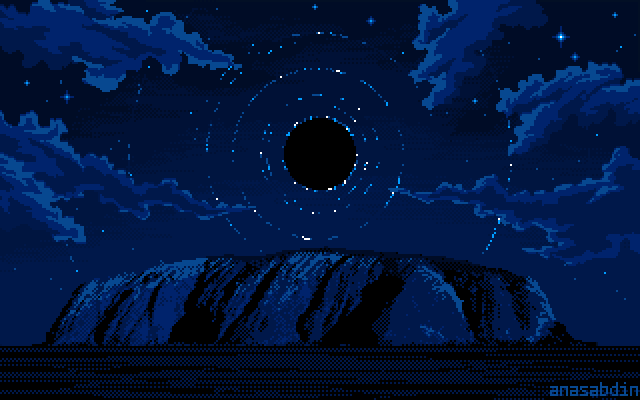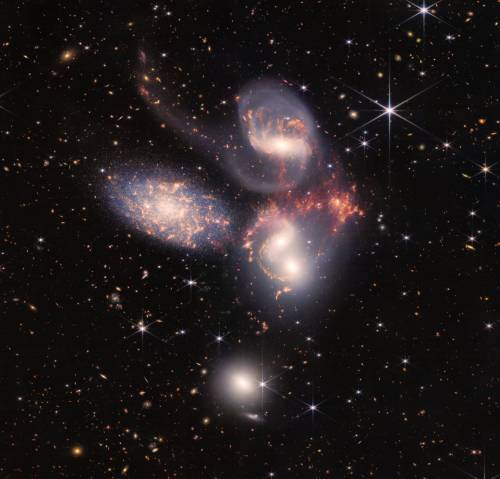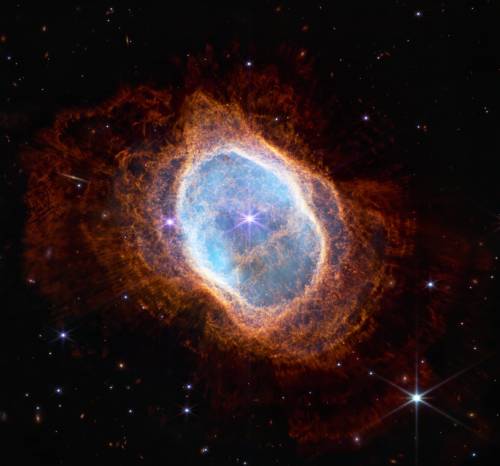Rings Of Gas Giants




Rings of Gas Giants
l Uranus (Chandra) l Neptune, Jupiter (Webb) l Saturn (Cassini)
More Posts from Of-finite-jurisdiction and Others

Chamaeleon Dark Nebulas : Sometimes the dark dust of interstellar space has an angular elegance. Such is the case toward the far-south constellation of Chamaeleon. Normally too faint to see, dark dust is best known for blocking visible light from stars and galaxies behind it. In this four-hour exposure, however, the dust is seen mostly in light of its own, with its strong red and near-infrared colors giving creating a brown hue. Contrastingly blue, the bright star Beta Chamaeleontis is visible just to the right of center, with the dust that surrounds it preferentially reflecting blue light from its primarily blue-white color. All of the pictured stars and dust occur in our own Milky Way Galaxy with – but one notable exception: the white spot just below Beta Chamaeleontis is the galaxy IC 3104 which lies far in the distance. Interstellar dust is mostly created in the cool atmospheres of giant stars and dispersed into space by stellar light, stellar winds, and stellar explosions such as supernovas. via NASA

Uluru blackh●le rise, me, pixel art, 2022

Space Station Silhouette on the Moon : What’s that unusual spot on the Moon? It’s the International Space Station. Using precise timing, the Earth-orbiting space platform was photographed in front of a partially lit gibbous Moon last month. The featured composite, taken from Payson, Arizona, USA last month, was intricately composed by combining, in part, many 1/2000-second images from a video of the ISS crossing the Moon. A close inspection of this unusually crisp ISS silhouette will reveal the outlines of numerous solar panels and trusses. The bright crater Tycho is visible on the upper left, as well as comparatively rough, light colored terrain known as highlands, and relatively smooth, dark colored areas known as maria. On-line tools can tell you when the International Space Station will be visible from your area. via NASA



NASA’s Webb Space Telescope Reveals Astounding, Unprecedented Views of the Universe
With NASA announcing their streaming service NASA+ and also announcing it’s going to be free and also ad free, I’d just like to appreciate the lengths they go to make scientific knowledge and exploration as available as they possibly can.










“Black Hole,” poem assembled from quotations from Wikipedia articles

Clearest image ever taken of Venus.
source: https://photojournal.jpl.nasa.gov/targetFamily/venus
So, this beautiful image from the James Webb telescope:

This is the Cliffs of Creation located in the Carina Nebula, approximately 7,600 lights years away.
We can see individual stars being born, eventually they will heat up enough to burn up their surrounding gases and dust.
This is the full Carina Nebula:

So... Where in this nebula are our beautiful cliffs?
Here:

Previously unseen, the James Webb has highlighted this amazing small bubble.
Edited: previous image I had highlighted the wrong area.

Jupiter Rotates : Observe the graceful twirl of our Solar System’s largest planet. Many interesting features of Jupiter’s enigmatic atmosphere, including dark belts and light zones, can be followed in detail. A careful inspection will reveal that different cloud layers rotate at slightly different speeds. The famous Great Red Spot is not visible at first – but soon rotates into view. Other smaller storm systems occasionally appear. As large as Jupiter is, it rotates in only 10 hours. Our small Earth, by comparison, takes 24 hours to complete a spin cycle. The featured high-resolution time-lapse video was captured over five nights earlier this month by a mid-sized telescope on an apartment balcony in Paris, France. Since hydrogen and helium gas are colorless, and those elements compose most of Jupiter’s expansive atmosphere, what trace elements create the observed colors of Jupiter’s clouds remains a topic of research. via NASA
The misconception that there is no sound in space originates because most space is a ~vacuum, providing no way for sound waves to travel. A galaxy cluster has so much gas that we've picked up actual sound. Here it's amplified, and mixed with other data, to hear a black hole!

-
 catalllo reblogged this · 1 month ago
catalllo reblogged this · 1 month ago -
 death-s-head-moth liked this · 1 month ago
death-s-head-moth liked this · 1 month ago -
 welcome-to-my-paradise-baby reblogged this · 1 month ago
welcome-to-my-paradise-baby reblogged this · 1 month ago -
 aprendiz-dual reblogged this · 1 month ago
aprendiz-dual reblogged this · 1 month ago -
 unseelie-robynx reblogged this · 1 month ago
unseelie-robynx reblogged this · 1 month ago -
 sithlord-darthzannah reblogged this · 1 month ago
sithlord-darthzannah reblogged this · 1 month ago -
 colorfullaudino liked this · 1 month ago
colorfullaudino liked this · 1 month ago -
 paradox-of-pisces reblogged this · 1 month ago
paradox-of-pisces reblogged this · 1 month ago -
 yesswimmingtimetravelcollectorus liked this · 1 month ago
yesswimmingtimetravelcollectorus liked this · 1 month ago -
 etherealdragonsrealm reblogged this · 1 month ago
etherealdragonsrealm reblogged this · 1 month ago -
 rabbitplanet reblogged this · 1 month ago
rabbitplanet reblogged this · 1 month ago -
 ourhauntedgrounds reblogged this · 1 month ago
ourhauntedgrounds reblogged this · 1 month ago -
 unseelie-robynx liked this · 1 month ago
unseelie-robynx liked this · 1 month ago -
 havvmaage liked this · 1 month ago
havvmaage liked this · 1 month ago -
 unreal-heir reblogged this · 1 month ago
unreal-heir reblogged this · 1 month ago -
 comatose-joy reblogged this · 1 month ago
comatose-joy reblogged this · 1 month ago -
 outsideintherain reblogged this · 1 month ago
outsideintherain reblogged this · 1 month ago -
 amitybrightlights liked this · 1 month ago
amitybrightlights liked this · 1 month ago -
 theawesomesaucestuff liked this · 1 month ago
theawesomesaucestuff liked this · 1 month ago -
 holyadoptionpapersbatman reblogged this · 1 month ago
holyadoptionpapersbatman reblogged this · 1 month ago -
 holyadoptionpapersbatman liked this · 1 month ago
holyadoptionpapersbatman liked this · 1 month ago -
 multifandomical liked this · 1 month ago
multifandomical liked this · 1 month ago -
 leoruby-draws reblogged this · 1 month ago
leoruby-draws reblogged this · 1 month ago -
 cigarmp3 reblogged this · 1 month ago
cigarmp3 reblogged this · 1 month ago -
 mothwinggs liked this · 1 month ago
mothwinggs liked this · 1 month ago -
 ttacc reblogged this · 1 month ago
ttacc reblogged this · 1 month ago -
 ttacc liked this · 1 month ago
ttacc liked this · 1 month ago -
 tantlemimes reblogged this · 1 month ago
tantlemimes reblogged this · 1 month ago -
 squintyfist liked this · 1 month ago
squintyfist liked this · 1 month ago -
 vexic929 reblogged this · 1 month ago
vexic929 reblogged this · 1 month ago -
 vexic929 liked this · 1 month ago
vexic929 liked this · 1 month ago -
 coolgirl reblogged this · 1 month ago
coolgirl reblogged this · 1 month ago -
 lakeshirtsecurity liked this · 1 month ago
lakeshirtsecurity liked this · 1 month ago -
 catlizard reblogged this · 1 month ago
catlizard reblogged this · 1 month ago -
 catlizard liked this · 1 month ago
catlizard liked this · 1 month ago -
 recitaramor reblogged this · 2 months ago
recitaramor reblogged this · 2 months ago -
 1000primer liked this · 2 months ago
1000primer liked this · 2 months ago -
 la-i-rd liked this · 2 months ago
la-i-rd liked this · 2 months ago -
 solamoon-art liked this · 2 months ago
solamoon-art liked this · 2 months ago -
 urania-n reblogged this · 2 months ago
urania-n reblogged this · 2 months ago -
 urania-n liked this · 2 months ago
urania-n liked this · 2 months ago -
 commonomonon reblogged this · 2 months ago
commonomonon reblogged this · 2 months ago -
 cite-ht-sea reblogged this · 2 months ago
cite-ht-sea reblogged this · 2 months ago -
 strawbebbey reblogged this · 2 months ago
strawbebbey reblogged this · 2 months ago -
 recitaramor liked this · 2 months ago
recitaramor liked this · 2 months ago -
 cosmiclycheese liked this · 2 months ago
cosmiclycheese liked this · 2 months ago -
 studyblrspace reblogged this · 2 months ago
studyblrspace reblogged this · 2 months ago -
 ourhauntedgrounds liked this · 2 months ago
ourhauntedgrounds liked this · 2 months ago -
 y2ksnowglobe reblogged this · 2 months ago
y2ksnowglobe reblogged this · 2 months ago

Finn OFJ’s space blog. Do you love space?? you better. or else
39 posts